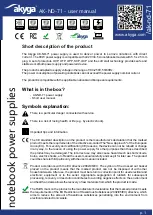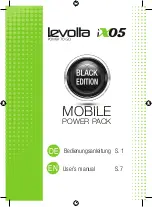
30
11.2. Glossary.
• AC.
Alternating current is electric current in which the mag-
nitude and direction vary cyclically. The waveform of the most
commonly used alternating current is that of a sine wave,
since this achieves a more efficient transmission of energy. In
certain applications, however, other periodic waveforms are
used, such as triangular or square.
• DC.
Direct current is the continuous flow of electrons through
a conductor between two points with different potential. Un-
like AC, in DC, electrical loads always circulate in the same
direction from the point of greatest potential to the lowest. Al-
though DC is commonly identified as a continuous current (for
example, that supplied by a battery), any current that always
maintains the same polarity is continuous.
• GND.
This stands for GROUND or EARTH and, as the name
indicates, refers to the potential of the surface of the Earth.
• Rectifier.
In electronics, a rectifier is the element or circuit
that converts AC into DC. This is done by using rectifier di-
odes, whether solid state semiconductors, vacuum valves or
gaseous valves, such as those containing mercury vapour.
Depending on the characteristics of the AC power that they
use, they are classified as single-phase when they are pow-
ered by a mains phase or three-phase when they are pow-
ered by three phases. Depending on the type of rectification,
they can be half wave when only one of the half cycles of the
current is used or full wave when both half cycles are used.
• Thyristor (gr.: gate).
An electronic component consisting of
semiconductor elements that uses internal feedback to pro-
duce switching. Its materials are of semiconductor type, that
is to say, depending on their temperature, they can function
as insulators or conductors. It is a one-way device because it
only transmits the current in a single direction. It is generally
used to control electrical power.
Some sources define the thyristor and silicon controlled recti-
fier (SCR) as synonyms; others define the SCR as a type of
thyristor, along with DIAC and TRIAC devices.
• Battery.
A device capable of storing electricity in the form
of chemical energy and, later, using electrochemical proce-
dures, producing electrical energy. This cycle can be repeated
for a certain number of times. It is a secondary electrical gen-
erator; that is, a generator that cannot operate without elec-
tricity being previously supplied through a charging process.
• Interface.
In electronics, telecommunications and hardware,
an interface (electronics) is the port (physical circuit) through
which signals are sent or received from one system or sub-
system to another.
• LCD.
Liquid crystal display, a device invented by Jack Jan-
ning, who was an employee of NCR. It is an electrical system
for data presentation formed by 2 transparent conductive
layers and a special crystalline material in the middle (liquid
crystal) which have the ability to orientate light as it passes
through.
• LED.
Light-emitting diode, a semiconductor device (diode)
that emits light that is almost monochromatic, that is to say, it
has a very narrow spectrum when it is polarised directly and is
penetrated by an electric current. The colour (wavelength) de-
pends on the semiconductor material used in the construction
of the diode, and can vary from ultraviolet, passing through
the visible light spectrum, to infrared, the latter called IRED
(infra-red emitting diode).
• Circuit breaker.
A circuit breaker is a device capable of in-
terrupting the electrical current of a circuit when it exceeds
certain maximum values.
USER MANUAL
Summary of Contents for DC POWER-L DC-75-L 12P 110V EE671774-1
Page 2: ...2 USER MANUAL...
Page 31: ...31 SALICRU...



































